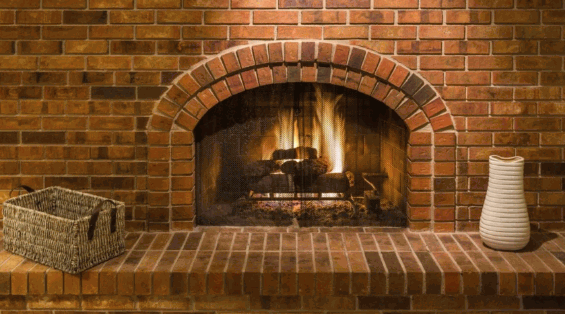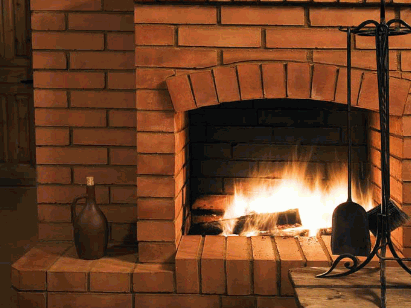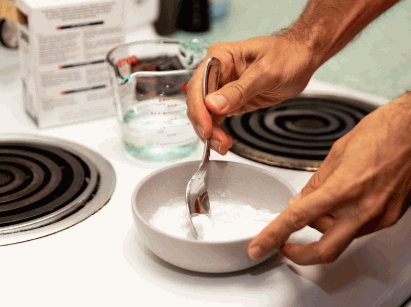
If you have a fireplace in your home, you know how important it is to keep the brick clean and well-maintained.
This article will discuss why it is essential to clean fireplace brick, the materials you will need, and a step-by-step guide on how to effectively clean it.
We will also provide tips for tackling stubborn stains and offer alternative cleaning methods.
Find out how often you should clean your fireplace brick and the precautions you should take to ensure a safe and successful cleaning process.

Table of Contents
Cleaning your brick fireplace is crucial for maintaining a safe and healthy living environment. Regular cleaning helps remove accumulated soot, grime, and debris that could pose fire hazards, improve air quality, and enhance the overall appearance of your fireplace.
Neglecting to clean your fireplace bricks can lead to chimney fires and health concerns, making it essential to incorporate cleaning as part of your routine maintenance. When soot and debris build up in the chimney, the risk of a chimney fire increases significantly. These fires can spread rapidly and cause extensive damage to your home, not to mention putting your family's safety at risk.
Regular maintenance and cleaning are key to preventing such dangers and ensuring that your fireplace remains both functional and safe. A clean fireplace contributes to better indoor air quality since the buildup of pollutants inside the chimney can seep into your home, affecting respiratory health.
Discover: How To Clean Smoke Damage From Painted Walls

To effectively clean the brick fireplace, suitable materials and tools are essential. These include a cleaning solution like a mixture of dish soap, water, vinegar, or bicarbonate of soda, a sponge or brush for scrubbing, safety goggles for eye protection, and if needed, commercial cleaning products formulated specifically for fireplace brick cleaning.
Regarding sourcing these cleaning materials, many can be easily found at your local grocery store or hardware store. The basic household items like dish soap and vinegar are generally readily available. For more specialised products designed for fireplace cleaning, you may want to visit a DIY store or check online for a wider selection.
It is crucial to ensure that the tools and solutions chosen are suitable for cleaning bricks in order to avoid damaging the surface. Investing in high-quality materials will not only make the cleaning process more effective but also help maintain the appearance and longevity of your brick fireplace.
Cleaning your fireplace brick efficiently involves a step-by-step process to ensure the thorough removal of dirt, grime, and soot. By following the right cleaning method and using appropriate solutions and tools, you can restore your fireplace bricks to their original beauty while maintaining safety precautions.
Before starting the cleaning process, make sure to put on your safety goggles to protect your eyes from any debris or cleaning chemicals. Ensure you have proper ventilation in the room by opening windows or using fans to avoid inhaling fumes.
To begin, mix a solution of warm water and mild dish soap in a bucket. Dip a scrub brush or sponge into the solution and gently scrub the bricks in a circular motion to loosen the dirt and soot.
Before starting the cleaning process, it is essential to prepare the area around the brick fireplace. Remove any furniture or decorative items near the fireplace to prevent them from getting dirty or damaged during cleaning. Place safety precautions such as warning signs to alert others about the ongoing cleaning process.
It is crucial to cover any nearby items that cannot be moved, like carpets or flooring, with protective materials. This will shield them from any potential splashes or stains during the cleaning process. Keep a fire extinguisher nearby as a safety measure in case of accidental fires.
Ensure proper ventilation in the room by opening windows or doors to allow fumes to escape and prevent the buildup of cleaning chemicals in the air. Taking these precautions will create a safe and efficient environment for cleaning the fireplace bricks.
Creating the right cleaning solution is key to effectively cleaning fireplace bricks. You can mix washing-up liquid, water, vinegar, bicarbonate of soda, or a mild cleaner to form a solution that will help break down dirt and grime on the bricks.
It's recommended to begin by preparing a mixture consisting of one part washing-up liquid to four parts warm water. This solution serves as an effective base to tackle surface dirt on the bricks. For tougher stains, a mixture of vinegar and bicarbonate of soda can be applied; the vinegar helps dissolve grime while the bicarbonate of soda acts as a gentle abrasive to lift stubborn residues.

Scrubbing the brick surface is a critical step in removing stubborn grime and soot build-up. Use a stiff-bristled brush or sponge to scrub the bricks gently but effectively, focusing on areas with visible dirt or stains.
To begin the cleaning process, start by mixing a solution of warm water and a mild detergent. Dip the brush or sponge into the soapy mixture and begin scrubbing the bricks in circular motions, ensuring thorough coverage. Pay extra attention to corners and crevices where dirt tends to accumulate. Rinse the bricks with clean water to remove soap residue, taking care not to oversaturate the surface. For tougher stains, consider using a specialised brick cleaner for optimal results.

After scrubbing the brick surface, rinse it thoroughly with clean water to remove any residue from the cleaning solution. Use a sponge or cloth dampened with water to wipe off the cleaning remnants and ensure the bricks are clean and free from cleaning agents.
Rinsing the fireplace bricks after scrubbing is a crucial step to ensure the removal of all remaining cleaning solution residues. Once you have gently scrubbed the bricks, take a clean sponge or cloth and soak it in freshwater. Begin by wiping the brick surface, making sure to cover all areas thoroughly.
It is essential to pay extra attention to corners and crevices where cleaning solution residues might accumulate. Continue rinsing and wringing the cloth or sponge to ensure that you are not spreading any leftover residue on the bricks.
To be certain that all remnants are removed effectively, consider using a second clean cloth or sponge with plain water for a final wipe-down. This extra step will guarantee that your fireplace bricks are completely free from any cleaning agents.
Once the bricks are cleaned and rinsed, allow them to dry completely before applying any sealing agents. Drying the bricks ensures that no moisture is trapped, which could lead to mould growth. If necessary, use a suitable sealant to protect the bricks and maintain their appearance.
After cleaning and rinsing the fireplace bricks, it is crucial to create a well-ventilated environment to aid the drying process. Place fans or open windows to facilitate the evaporation of any remaining moisture. Thorough drying is essential to avoid the formation of mould, which thrives in damp conditions.
When choosing a sealant for the fireplace bricks, opt for silicone-based products that are specifically designed for masonry surfaces. These sealants provide excellent protection against moisture and heat. Before application, carefully read and follow the manufacturer's instructions to achieve the best results.
When dealing with stubborn stains on fireplace bricks, spot cleaning is an effective technique. Saturate the stained area with a mild cleaner, let it sit for a few minutes, then gently scrub with a stiff-bristled brush to lift the stain. Repeat the process if necessary until the stubborn stain is removed.
For oil or grease stains, try sprinkling some bicarbonate of soda on the affected area after cleaning with a mild detergent. This can help absorb any remaining residue.
For soot and smoke stains, consider using a mixture of vinegar and water to break down the build-up. Apply the solution, let it work its magic, and then scrub away with the brush.

The frequency of cleaning your fireplace bricks may vary depending on usage and environmental factors.
For regular residential use, it is recommended to clean the fireplace bricks at least once a year. If the fireplace is used frequently or for rental properties like Airbnb or end-of-tenancy cleaning, more frequent cleaning may be necessary to maintain a clean and presentable appearance. Factors such as the type of fuel used, the presence of pets in the household, and the level of soot buildup can also influence how often cleaning is needed. It's essential to visually inspect the bricks regularly to assess if there is a noticeable buildup of creosote, dirt, or stains that detract from the overall aesthetics of the fireplace.
Plus traditional cleaning solutions, there are alternative methods for cleaning fireplace bricks. These include using a vinegar and water solution for mild cleaning, a baking soda and water paste for tougher stains, or commercial cleaning products containing boric acid for specialised cleaning needs.
When dealing with light soot and grime, the vinegar and water solution can be a gentle yet effective option. Simply mix equal parts vinegar and water in a spray bottle, apply it to the bricks, and scrub with a brush.
For more stubborn stains, the baking soda and water paste works wonders. Mix baking soda with a small amount of water to create a thick paste, apply it to the stains, let it sit for a while, and then scrub away.
In cases where heavy-duty cleaning is required, commercial products that contain boric acid can provide a powerful solution.
A vinegar and water solution is a natural and effective way to clean fireplace bricks. Mix equal parts of vinegar and water, saturate a sponge or cloth with the solution, and gently scrub the brick surface to remove dirt and grime. The mild acidity of vinegar helps break down stains without harsh chemicals.
The acidity of vinegar also helps to kill bacteria and mould spores present on the brick surface, making it a hygienic cleaning option. The gentle nature of this solution makes it ideal for preserving the integrity of the bricks, avoiding any potential damage that harsh chemicals may cause. After scrubbing the bricks, rinse the surface with clean water and dry it thoroughly to reveal a clean and refreshed fireplace.
Using this natural remedy not only cleans but also leaves a pleasant, subtle scent behind, unlike chemical cleaners that can leave strong, artificial odours.

Creating a bicarbonate of soda and water paste is an excellent option for dealing with tough stains on fireplace bricks. Mix the bicarbonate of soda and water to form a paste, apply it to the stained areas, allow it to sit for some time to saturate the stains, and then scrub gently with a brush or sponge to remove the dirt. Rinse with water to reveal clean bricks.
To make the paste, begin by mixing bicarbonate of soda and water in a small bowl until a thick, spreadable consistency is achieved. Ensure the mixture is not too runny or too dry. Using a spoon or spatula, apply the paste generously to the stained parts of the fireplace bricks. Allow the paste to work its magic by leaving it undisturbed for about 30 minutes or until it dries.
After the waiting time is up, take a stiff-bristled brush or a sponge and start scrubbing the treated areas in small circular motions. Apply gentle pressure to avoid damaging the bricks while still effectively removing the stains. Continue scrubbing until you notice the residue starting to lift off the bricks, revealing a cleaner surface underneath.
Once you've scrubbed all the stained areas, take a clean damp cloth or sponge and wipe off the excess bicarbonate of soda paste. Rinse the bricks thoroughly with clean water to remove any remaining residue. Step back and admire your fireplace as the stains disappear, leaving behind a fresh and rejuvenated appearance.

For specialised cleaning needs, commercial brick cleaners containing ingredients like boric acid, foaming bathroom cleaners, or ammonia can be effective. Follow the manufacturer's instructions for these products, saturate the bricks as directed, and scrub gently to remove dirt and grime.
When choosing a commercial brick cleaner, consider the specific requirements of your fireplace bricks. Boric acid-based cleaners are great for removing tough stains and deposits while foaming bathroom cleaners can effectively tackle soap scum and mineral build-up. Ammonia-based cleaners work well for general cleaning and degreasing.
To apply the cleaner, start by testing it on a small, inconspicuous area of the bricks to ensure compatibility. Once confirmed, apply the cleaner generously to the bricks, ensuring they are thoroughly saturated. Allow the cleaner to sit for the recommended time before gently scrubbing with a brush or sponge.

When cleaning fireplace bricks, it is essential to observe specific safety precautions to protect yourself and the surrounding environment. Always wear safety goggles to minimise health risks, and consider professional services for complex cleaning tasks.
Safety goggles and gloves are not just accessories; they are crucial protective gear that can prevent injuries and exposure to harmful chemicals during the cleaning process. By using these simple items, you are investing in your well-being and ensuring a safe cleaning procedure.
Professional cleaning services can play a significant role, especially when dealing with stubborn stains or deeply embedded dirt in the bricks. These experts have the knowledge, experience, and specialised equipment to handle challenging cleaning tasks effectively, leaving your fireplace looking pristine while maintaining a safe and healthy environment for you and your loved ones.